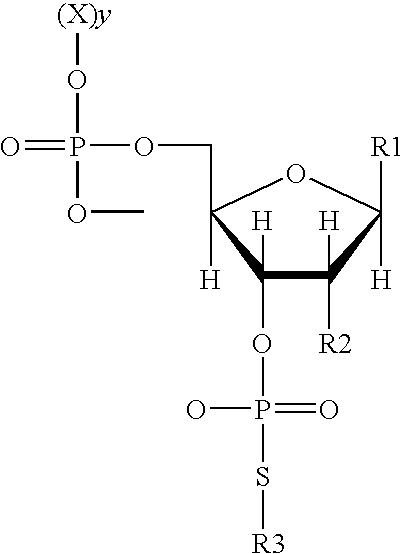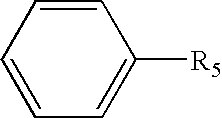Use of phosphorothiolate polynucleotides in ligating nucleic acids
a technology of phosphorothiolate and polynucleotide, which is applied in the field of molecular cloning, can solve the problems of inability to use direct cloning, less flexible “topo cloning” method than standard cloning method, and generally time-consuming steps
- Summary
- Abstract
- Description
- Claims
- Application Information
AI Technical Summary
Problems solved by technology
Method used
Image
Examples
example i
Nonenzymatic Ligation of Nucleic Acid
[0150]This example shows that a polynucleotide 3′-phosphorothiolate can be ligated to an acceptor polynucleotide.
[0151]A polynucleotide 3-phosphorothiolate mediates non-enzymatic ligation through a mechanism analogous to that of a topoisomerase. Topoisomerase-mediated ligation is effective because the 3′-phosphotyrosine is a relatively high energy intermediate and therefore labile; formation of a 5′-3′ DNA phosphodiester bond is extremely stable and energetically favored. Topoisomerases require no external energy source (e.g. ATP) to catalyze the cleavage and ligation reactions. It was hypothesized that other chemically modified 3′-phosphodiesters could mimic this labile intermediate. To test this hypothesis an oligonucleotide containing a 3′-S-(paranitrophenyl) moiety (termed 3′-SNP) was prepared. This compound contains a substitution of a sulfur for an oxygen because sulfur-phosphorous bonds are significantly more labile than oxygen-phosphorous...
example ii
Covalent Bond Formation Between Topo65 and 5′-Phosphorothiolate-Containing Polynucleotides
[0153]This example shows that Topo65 can cleave a duplex DNA molecule containing a 5′-phosphorothiolate moiety located two or four base pairs upstream from a blunt end.
[0154]To determine if Topo65, a recombinant form of human topoisomerase I, described in detail below, can cleave near the end of a duplex DNA molecule, Topo65 was incubated with oligonucleotide substrates containing 5′-phosphorothiolate moieties located two or four base pairs upstream from a blunt end. The duplex substrates contained nucleic acid sequences at their 3′ end that, when cleaved by Topo65, would generate 2 and 4 base overhangs compatible with terminal end overhangs generated by the restriction enzymes BstBI and BamHI, respectively. The substrates contained a 5′-EcoRI overhang on the other end of the duplex oligonucleotide so that the duplex oligonucleotides could be ligated, using standard T4 DNA ligase, onto linear p...
example iii
Topo65 Mediated Ligation of Oligonucleotide Substrates
[0164]This example shows Topo65 mediated ligation of oligonucleotide substrates following cleavage at the 5′-bridging phosphorothiolate located near the end of a DNA duplex.
[0165]The SDS-PAGE analysis depicted in FIG. 4 demonstrates that topo I is capable of reacting with the oligo duplex substrates. In order to determine the fate of the substrates themselves, the duplex oligonucleotide substrates shown in FIG. 5A were reacted with Topo65 and the oligonucleotide reaction products were examined by both native and denaturing PAGE (FIGS. 5A and 5B, respectively). Through this analysis, the efficient Topo65-mediated generation of dimeric (about 50 bp) and even trimeric (about 70 bp) DNA molecules was observed (FIG. 5B, lanes 4 and 5).
[0166]FIG. 5A depicts oligonucleotide substrates reacted with Topo65, labeled as Oligo pairs 1 through 6. Oligonucleotide substrates (pairs 1 to 3) were reacted with Topo65, adjusted to 500 mM NaCl or NO...
PUM
| Property | Measurement | Unit |
|---|---|---|
| temperature | aaaaa | aaaaa |
| temperature | aaaaa | aaaaa |
| temperatures | aaaaa | aaaaa |
Abstract
Description
Claims
Application Information
 Login to View More
Login to View More - R&D
- Intellectual Property
- Life Sciences
- Materials
- Tech Scout
- Unparalleled Data Quality
- Higher Quality Content
- 60% Fewer Hallucinations
Browse by: Latest US Patents, China's latest patents, Technical Efficacy Thesaurus, Application Domain, Technology Topic, Popular Technical Reports.
© 2025 PatSnap. All rights reserved.Legal|Privacy policy|Modern Slavery Act Transparency Statement|Sitemap|About US| Contact US: help@patsnap.com



